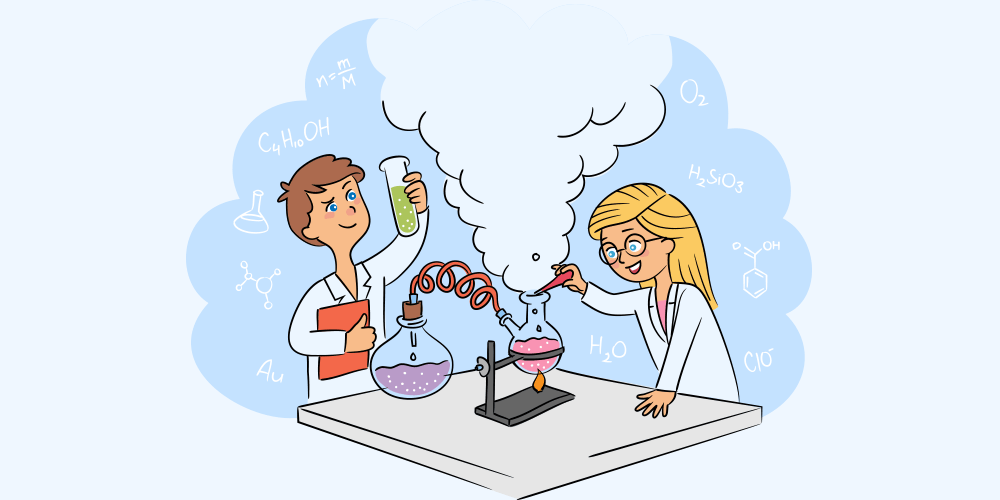10 Easy Science Experiments For Young Scientists
- admin
- 2022-09-30
- 6 min read

Is your kid a budding scientist? If yes, you’ll undoubtedly want to think of ways to encourage their enthusiasm for STEM (science, technology, engineering, and mathematics) subjects. Fortunately, children of all ages can learn from even the most basic science experiments carried out at home. Check out these 10 easy science experiments for young scientists.
1. Lava Lamp
Contents
Children aged 4 to 12 (and beyond!) really like this easy experiment, and it will send the adults back in time as well. Kids may learn about density via these simple and easy science experiments.
You’ll need:
a) A clean bottle of plastic (or several plastic bottles)
b) Water
c) Plant-based oil
d) Fizzing tablets (like an alka-seltzer tablet)
e) Coloring agents
Steps:
Water should be added to the bottle until it is about 1/4 full. Fill the rest of the bottle to the top with vegetable oil. If you have a funnel, use it.
Then, include a few drops of food colouring in your chosen colour. Keep an eye on the colour as it passes through oil. Then add the fizzing tablet.
The tablet will sink through oil and combine with water. Carbon dioxide gas is produced as the tablet dissolves. This creates a beautiful, colourful lamp, because of the emission of gas!
2. Surface Tension (Using Black Pepper!)
Even young children must learn about surface tension, which is a fundamental science concept.
You’ll need:
a) Black pepper
b) A dish
c) Water
d) Liquid soap
Steps:
First, pour a thin coating of water on a plate—less than an inch should do.
Next, sprinkle pepper over the water, trying to cover as much of the surface as you can. More pepper equals more fun.
Last but not the least, dab your finger in the liquid soap. Touch the pepper to witness the soap releasing the water’s surface tension!
The water’s surface tension is broken by the soap. Because water molecules tend to cling together, there is surface tension in water.
3. Homemade Slime
Young children love playing with slime. The fact that kids will love this scientific experiment makes it one of our favourites.
Materials:
a) Water
b) School glue in white
c) Food colouring
d) Borax
e) Two bowls
Steps:
In a bowl, first combine 1/4 cup water and 1/4 cup white school glue. (If you would like extra, double the amount.)
Next, add a few drops of food colouring to the mixture to make your slime.
After that, whisk together 1/2 cup of water and 1/2 tablespoon of borax until the borax dissolves.
You and your kid just invented slime at home! You can also try some fun educational activity at home.
4. Dancing raisins
A few basic supplies that you probably already have in your home are required for this extremely simple scientific experiment that is ideal for young children.
You’ll require:
a) Clear Soda
b) A clear glass of water
c) Several raisins
Steps:
Start by pouring ordinary water or similar liquid without gas bubbles in one glass and clear soda in the other. After that, add raisins to each glass and observe how they behave with the clear soda.
The soda’s gas bubbles lift the raisins into the air. The raisins dip again as they explode.
When the carbon dioxide bubbles reach the soda’s surface, they pop, releasing the gas into the air. As a result, the raisin loses buoyancy and falls back to the glass’s bottom. Because of this, the raisin behaves differently in various liquids.
5. Float or Sink
This simple scientific experiment will appeal to children of all ages, but especially young ones, since it lays the groundwork for understanding density.
You’ll require:
a) Two glasses of water
b) Small items from around the house
c) A piece of paper and a pen
Steps:
Start by adding water to two large, transparent containers. Then, instruct your children to collect little objects from around the home to see if they would sink or float.
Ask your children to make a list of the things on paper and predict whether or not they will float or sink before you test them.
Test each item now, then compare the results to their predictions! This is a fantastic technique to teach the scientific concept of density to children.
6. Cleaning Dirty Pennies
You undoubtedly have some dirty coins laying around your home, so utilize them for an easy science experiments that even small children will find entertaining. Pennies are made of copper and have a long shelf life, so they frequently have a tarnished appearance. You’ll find out in this experiment if soap, vinegar, or other liquids work better at cleaning the dirty copper pennies.
The pennies were seen to have a shinier appearance with vinegar in comparison to soap.
7. Rainbow Celery (Capillary Action)
Do you have any celery in the fridge? Then, using a quick and eye-catching experiment with colour-changing celery, you may start learning about capillary action. Your kids will cherish this craft for years to come since it’s so cool!
What you require:
a) Celery
b) Glasses of water
c) Food colouring
Steps:
Choose a sunny location and half-fill the cups with water.
After that, add various shades of food colouring to each glass.
Slice celery stalks and add them to the water glasses. You might also do this experiment using a flower that is light in colour.
Give the celery some time to sit. The leaves will start to change colour after a few hours.
With the help of this simple experiment, you can show your child how the celery stalks’ tiny vessels may transport water to the leaves, simulating the flow of blood in the human body.
8. Water Fireworks
This completely safe fireworks experiment will be popular during Diwali!
Materials:
a) Tall glass of water
b) Small glass of water
c) Oil
d) Food colouring
e) Fork
Steps:
Start by almost completely filling your glass with water. Add two teaspoons of oil to the small glass. Until it is broken up into smaller specks, add 2 drops of food colouring and stir the mixture with a fork.
Watch as the firework expands after adding the oil mixture to the water.
9. Mixing Impossible Liquids
In this really simple experiment, oil and water are combined in equal quantities with a drop of food colouring to observe what happens. The process of the food colouring passing through the oil will fascinate children. The colour passes straight through oil without mixing. However, it will mix with water.
The children would love to know about different densities of liquids and you’ll like how simple it is to set up and take down!
10. Tie-Dye
Who would have guessed that everyone’s favourite t-shirt pattern is also a fantastic scientific lesson? All you need are some rubber bands, buckets, dye, and an old white t-shirt or pillowcase.
Next, roll up your t-shirt and carefully knot each rubber band at the ends to make a pattern.
Start by dipping the t-shirt into each colour of dye.
Your youngster will be able to watch the water solubility and absorption in action as they colour the shirt. Because the dyes are fibre-reactive, a chemical reaction occurs between the dye molecules and the fabric molecules, fusing them together. The dye fuses with the cloth and essentially turns into a component of it.
Wrapping up
There is science everywhere! Allow children to lead the way as you explore and learn together. Your scientific journey will become considerably more worthwhile and meaningful as a result. Your children will cherish these special connections for the rest of their lives!
So go forth and create some science with these fun experiments to do with your kids.
Also Read, twitter accounts for young scientists.
21K School
Read our latest education blogs here. We are pioneers in proffering personalised, affordable and high-quality lessons using an advanced learning platform.


Join Asia’s Leading Online School and Unlock
endless opportunities
Join Asia’s
Leading Online School
and Unlock endless opportunities

 Thailand
Thailand




